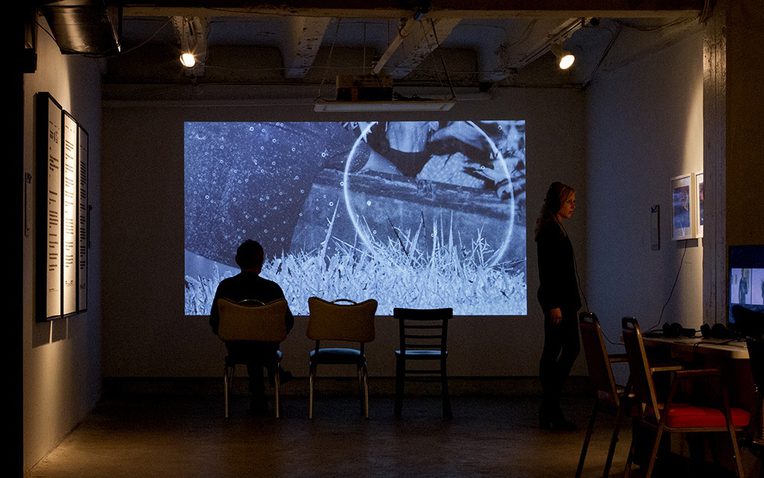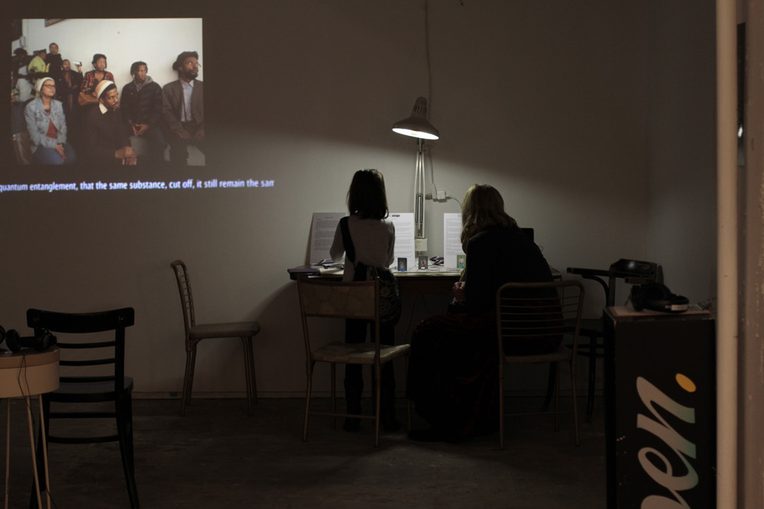
Review: Ethnographic Terminalia 2014, Hierarchy, Washington, D.C., December 3–7
Ethnographic Terminalia is a curatorial collective that since 2009 has been curating group exhibitions as 'para-sites' or 'off-site installations' to the annual meetings of the American Anthropological Assocaiton. These exhibits are "gounded in a commitment to pushing the boundaries of anthropological scholarship and contemporary art" demonstrating "how contemporary artists, anthropologists and institutions are engaging with ethnographic methodologies and art." We have the pleasure of presenting the review of their latest exhibit, The Bureau of Memories: Archives and Ephemera, at the Hierarchy Gallery in Washington DC written by Paul Stoller.

For the Songhay people of the Republics of Niger and Mali in West Africa history is more than a series of dead words on a page that recount the stories of the past. For them, history is also a set of ever-living forces that sensuously bring the past into the dynamic flow of contemporary life.
The great reigns of fifteenth- and sixteenth-century Songhay kings (the dynasty of the Askias) are indeed recounted in two historical texts written in the seventeenth century, Mohammed es-Saadi’s Tarikh al-Soudan and Mahmoud Kati’s Tarikh al-Fattach. These texts describe imperial governance, royal rivalries, political tensions, and great military exercises. These invaluable works, however, do not dwell on the texture of social life. How did sixteenth- and seventeenth-century Songhay people cope with the vicissitudes of an unpredictable climate that powerfully dictated the health and well-being of urban and rural populations? Would the spirits bring rains in a given year or would they ensure yet another season of drought, yet another period of hunger and suffering? How did the people of that time adjust to incessant warfare, let alone the expansion of Islam? How did these powerful forces shape the quality of social life?
These existential questions introduce us to histories "from below" that are not often articulated on the pages of a book that resides in an classic library; rather, they are evoked in rituals like spirit possession during which words, music, movement, and smell sweep the sensuous past into the vibrant present. The old words of incantations and praise-poetry speak to the existential relations of past and present. The sound of the monochord violin "cries" for ancestral recognition such that the links between past and present might be restored. The danced movements of spirit mediums evoke the mythic stories of the "distant past." The smells of Bint-al Sudan provoke the onset of possession, a truly dramatic transformation that sensuously compresses past and present. In the moment of possession historical, social and cultural memory converge in the body of the medium. It is a moment when the forces of the cosmos speak truth to power and bear witness to the challenges of living in the world.
For many peoples there is a tactile dimension to history in which memories are brought to life in multifaceted archival arenas. These are arenas in which people are able to hear, smell, and touch the past—activities that bring distant time instinctually into the present.
One of the great challenges for contemporary ethnographers and artists, then, is to re-awaken our tactile sense of the past, to create multi-sensorial spaces in which the stories of the past are told and retold, understood and comprehended anew through prisms of sound, scent, movement, and touch. The multi-modal installations that comprised the seventh Ethnographic Terminalia, The Bureau of Memories: Archives and Ephemera met this contemporary representational challenge—and did so admirably through twenty-six thought-provoking and boundary-challenging "historical" works.
As a curated collection the installation wonders "what lies beyond and what lies within disciplinary territories. The terminus is the end the boundary and the border; it is also a beginning, its own place, a site of experience and encounter" (Ethnographic Terminalia Collective 2014, i). In The Bureau of Memories, artists and anthropologists re-imagine and remix twentieth-century media including 16mm film, short-wave radio, land-line telephones, photogravure, and paper documents, all of which invite
visitors to encounter voices and images from the past in a technological space that is both historical and contemporary. . . . The Bureau of Memories considers archives as sites of official records and broken fragments. Bureaucratically mundane and incongruously playful items slip through the cracks of established narratives, pointing toward fissures in the structures of historical memory. The installation draws out anthropology’s uncanny specters, reinterpreting archives not only as repositories of information but as generators of absence and obscurity.
Here are some examples from a few of the works that comprised The Bureau of Memories: "REACH in Ambler" is an installation about the asbestos producing factory community of Ambler which is located near Philadelphia. The installation evokes questions of governmentality, community organizing, and how decisions are made—to close the asbestos factory. The five-minute filmlet, based on interviews, oral histories, tours, and field research "explores the boundaries between methodology, empiricism, and research reflexivity as they converge in visual media" (Tarditi, Zuberi and Ziv. Ibid. 5). Put another way, through image and sound this installation explores the spaces between things.
The same can be said of "The Ward: Dubois and Oral Histories," an installation that features an interactive space "for users to 'play' board games as they watch and hear about the life of civil rights activists from the Seventh War (Philadelphia) community. By thinking outside the book and even outside of the film we seek to think about the many ways that learning (i.e. kinesthetic, audiovisual, etc.) can occur and the differential possibilities which tactile interaction might provide for active engagement with 'lived' histories" (Brodie, Hillier and Laughlin 2014, Ibid. 7). Here again the installation takes us "between" learning modalities.

The tactility of history is also showcased in Amber Lincoln’s "History Felt: Alaska Peninsula Reindeer Herding," a history patched together from "memos, rangeland permits, and maps housed in the U.S. National Archives, historical photos and tools in individual collections and museums." Here the history of reindeer herding is constructed from the "design of documents, the texture of objects, and the rhythm of voices" that one can hear see and feel while seated on a reindeer pelted installation chair—a point of reception for the multi-modal telling and re-telling stories (Lincoln 2014 Ibid, 15). Here again the installation takes us to a bridge that spans the spaces between past and present, between being-there and being-here.
Space precludes a description of the twenty-three other evocative multi-sensory installations in The Bureau Memories, each of which singularly explores the existential boundaries of past and present. In those installations, ethnographers and artists employed a variety of media, artistic techniques, and machines (film, video, photography, photoetchings, and digital imagery, recordings, audio-photo series, re-mixing and reinventing sound, sound machines, ecstatic truths and translation, and photoboxes) to probe the outer reaches of our historical and symbolic imagination.
Put in a slightly different language, The Bureau of Memory is an embodied exploration of what medieval Sufi mystics like Ibn al’ Arabi called "the between"—indeterminate spaces that are neither here nor there. For him, the between is
something that separates . . . two other things, while never going to one side . . . as, for example, the line that separates shadow from sun light. God says, "he let forth this two seas that meet together, between them a barzakh they do not overpass" (Koroan 55:19); in other words one sea does not mix with the other . . . any two adjacent things are in need of barzakh, which is neither one nor the other but which possesses the power . . . of both. The barzakh is something that separates a known from an unknown, an existent from a non-existent, a negated from an affirmed, an intelligible from a non-intelligible. (Crapanzano 2003, 57–58; see also Chittick 1989; Stoller 2008)
In the mystical world of the Sufis, the spaces between things are indeterminate. For them, it is the indeterminacy of these spaces that fires our imagination. The between, then, is a challengingly liminal place where we innovate and invent. As demonstrated in installations that constitute The Bureau of Memories, it is in liminal spaces that we blend elements—poised on the barzakh—to refashion the world and unleash some of its wonders. As Crapanzano (2003, 58) notes:
The liminal has often been likened to the dream. . . . It suggests imaginative possibilities that are not necessarily available to us in everyday life. Through paradox, ambiguity, contradiction, bizarre, exaggerated, and at times grotesque symbols—masks, costumes and figurines—and the evocation of transcendent realities mystery and supernatural powers, the liminal offers us a view of the world to which we are normally blinded by the usual structures of social and cultural life.
In our disciplinary corner of the world, we have written a great deal about ethnographic representation—writing about writing. There has also been much recent debate about the social challenges of the Anthropocene as well as the twists and turns of ontology in social description. No matter the turn of these debates, they have usually consisted of linear arguments presented in a textual format—all in search for what John Dewey (1929) long ago called "the quest for certainty." The format of these arguments has often taken us away from the murky, creative spaces between things.
Enter The Bureau of Memories. With its inclusively tactile and multi-sensorial dimensions, the exhibition demonstrates the central importance of a new wave of anthropological expression, an articulation that fuses past and present and here and there. In short, The Bureau of Memories invites us to glimpse into the future and provides a much-appreciated tonic for our discipline.
Photographs




References
Brodie, Stephanie, Amy Hiller and Corrina Laughlin. 2014. "The Ward: Dubois and Oral Histories." The Bureau of Memories: Archives and Ephemera. Installation catelogue. Washington D.C.
Chittick, William C. 1989. The Sufi Path of Knowledge: Ibn al-Arabi's Metaphysics of Imagination. Albany, N.Y.: SUNY Press.
Crapanzano, Vincent. 2003. Imaginative Horizons: An Essay in Literary-Philosophical Anthropology. Chicago: University of Chicago Press.
Dewey, John. 1929. The Quest for Certainty: A Study of the Relation of Knowledge and Action. New York: Minton, Balch.
Es-Saadi, Mohammed. 1900. Tarikh es Soudan. Translated by O. Houdas. Paris: Leroux.
Ethnographic Terminalia Curatorial Collective. 2014. The Bureau of Memories: Archives and Ephemera. Installation catelogue. Washington D.C.
Kati, Mahmoud. 1913. Tarikh al-Fattach. Translated by M. Delafosse. Paris: Maissoneuve.
Lincoln, Amber. 2014. "History Felt: Alaska Peninsula Reindeer Herding." The Bureau of Memories: Archives and Ephemera. Installation catelogue. Washington D.C.
Stoller, Paul. 2008. The Power of the Between: An Anthropological Odyssey. Chicago: University of Chicago Press.
Tarditi,Matthew, Jabari Zuberi and Tali Ziv. 2014. "REACH: In Ambler (REACH= Resources for Education and Action for Community Health). The Bureau of Memories: Archives and Ephemera. Installation catelogue. Washington D.C.